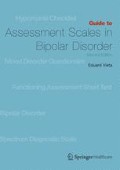Abstract
In recent years, estimates of the lifetime prevalence of bipolar disorder have been extensively revised. Historical rates of 1–2% [1]have now increased to 5–7% [2], although there is widespread variation, with European data indicating a prevalence of 0.6–0.8% [3]and some lifetime estimates of bipolar spectrum disorder as high as 24% [4].
Access this chapter
Tax calculation will be finalised at checkout
Purchases are for personal use only
Preview
Unable to display preview. Download preview PDF.
References
Kessler RC, McGonagle KA, Zhao S, et al. Lifetime and 12-month prevalence of DSM-III-R psychiatric disorders in the United States: results from the National Comorbidity Survey. Arch Gen Psychiatry 1994; 51:8–19.
Akiskal HS, Bourgeois ML, Angst J, et al. Re-evaluating the prevalence of and diagnostic composition within the broad clinical spectrum of bipolar disorders. J Affect Disord 2000; 59:S5–S30.
Fajutrao L, Locklear J, Priaulx J, et al. A systematic review of the evidence of the burden of bipolar disorder in Europe. Clin Pract Epidemol Ment Health 2009; 5:3.
Angst J. The emerging epidemiology of hypomania and bipolar II disorder. J Affect Disord 1998; 50:143–51.
Judd LL, Akiskal HS. The prevalence and disability of bipolar spectrum disorders in the US population: re-analysis of the ECA database taking into account subthreshold cases. J Affect Disord 2003; 73:123–31.
Hirschfeld RM, Lewis L, Vornik LA. Perceptions and impact of bipolar disorder: how far have we really come? Results of the National Depressive and Manic-Depressive Association 2000 survey of individuals with bipolar disorder. J Clin Psychiatry 2003; 64:161–74.
Baca-Garcia E, Perez-Rodriguez MM, Basurte-Villamor I, et al. Diagnostic stability of psychiatric disorders in clinical practice. Br J Psychiatry 2007; 190:210–6.
Salvatore P, Baldessarini RJ, Tohen M, et al. McLean-Harvard International first-episode project: two-year stability of DSM-IV diagnoses in 500 first-year episode psychotic disorder patients. J Clin Psychiatry 2009; 70:458–66.
Perugi G, Micheli C, Akiskal HS, et al. Polarity of the first episode, clinical characteristics, and course of manic depressive illness: a systematic retrospective investigation of 320 bipolar I patients. Compr Psychiatry 2000; 41:13–8.
Bowden CL. Strategies to reduce misdiagnosis of bipolar depression. Psychiatr Serv 2001; 52:51–5.
Ghaemi SN, Sachs GS, Chiou AM, et al. Is bipolar disorder still underdiagnosed? Are antidepressants overutilized? J Affect Disord 1999; 52:135–44.
Altshuler LL, Post RM, Leverich GS, et al. Antidepressant-induced mania and cycle acceleration: a controversy revisited. Am J Psychiatry 1995; 152:1130–8.
Ghaemi SN, Boiman EE, Goodwin FK. Diagnosing bipolar disorder and the effect of antidepressants: a naturalistic study. J Clin Psychiatry 2000; 61:804–8.
Hirschfeld RMA, Bowden CL, Perlis RH, et al. Practice guideline for the treatment of patients with bipolar disorder (revision). Am J Psychiatry 2002; 159:1–50.
Swann AC, Bowden CL, Calabrese JR, et al. Differential effect of number of previous episodes of affective disorder on response to lithium or divalproex in acute mania. Am J Psychiatry 1999; 156:1264–6.
Tondo L, Baldessarini RJ. Reduced suicide risk during lithium maintenance treatment. J Clin Psychiatry 2000; 61:97–104.
Geller B, Cooper TB, Sun K, et al. Double-blind and placebo-controlled study of lithium for adolescent bipolar disorders with secondary substance dependency. J Am Acad Child Adolesc Psychiatry 1998; 37:171–8.
Piver A, Yatham LN, Lam RW. Bipolar spectrum disorders. New perspectives. Can Fam Physician 2002; 48:896–904.
Manning JS, Haykal RF, Connor PD, et al. On the nature of depressive and anxious states in a family practice setting: the high prevalence of bipolar II and related disorders in a cohort followed longitudinally. Compr Psychiatry 1997; 38:102–8.
Glick ID. Undiagnosed bipolar disorder: new syndromes and new treatments. Prim Care Companion J Clin Psychiatry 2004; 6:27–33.
Ghaemi SN, Hsu DJ, Ko JY, et al. Bipolar spectrum disorder: a pilot study. Psychopathology 2004; 37:222–6.
Hirschfeld RMA, Williams JB, Spitzer RL, et al. Development and validation of a screening instrument for bipolar spectrum disorder: the Mood Disorder Questionnaire. Am J Psychiatry 2000; 157:1873–5.
Hirschfeld RMA, Holzer C, Calabrese JR, et al. Validity of the Mood Disorder Questionnaire: a general population study. Am J Psychiatry 2003; 160:178–180.
Miller CJ, Klugman J, Berv DA, et al. Sensitivity and specificity of the Mood Disorder Questionnaire for detecting bipolar disorder. J Affect Disord 2004; 81:167–71.
Twiss J, Jones S, Anderson I. Validation of the Mood Disorder Questionnaire for screening for bipolar disorder in a UK sample. J Affect Disord 2008; 110:180–4.
Weber Rouget B, Gervasoni N, Dubuis V, et al. Screening for bipolar disorders using a French version of the Mood Disorder Questionnaire (MDQ). J Affect Disord 2005; 88:103–8.
Gervasoni N, Weber Rouget B, Miguez M, et al. Performance of the Mood Disorder Questionnaire (MDQ) according to bipolar subtype and symptom severity. Eur Psychiatry 2009; in press.
Sanchez-Moreno J, Villagran JM, Gutierrez JR, et al. Adaptation and validation of the Spanish version of the Mood Disorder Questionnaire for the detection of bipolar disorder. Bipolar Disord 2008; 10:400–12.
Tafalla M, Sanchez-Moreno J, Diez T, et al. Screening for bipolar disorder in a Spanish sample of outpatients with current major depressive episode. Affect Disord 2009; 114:299–304.
Isometsä E, Suominen K, Mantere O, et al. The Mood Disorder Questionnaire improves recognition of bipolar disorder in psychiatric care. BMC Psychiatry 2003; 3:8.
Chung KF, Tso KC, Cheung E, et al. Validation of the Chinese version of the Mood Disorder Questionnaire in a psychiatric population in Hong Kong. Psychiatry Clin Neurosci 2008; 62: 464–71.
Konuk N, Kiran S, Tamam L, et al. [Validation of the Turkish version of the mood disorder questionnaire for screening bipolar disorders]. Turk Psikiyatri Derg 2007; 18:147–54.
Shabani A, Koohi-Habibi L, Nojomi M, et al. The persian bipolar spectrum diagnostic scale and mood disorder questionnaire in screening the patients with bipolar disorder. Arch Iran Med 2009; 12:41–7.
Author information
Authors and Affiliations
Rights and permissions
Copyright information
© 2010 Current Medicine Group Ltd, a part of Springer Science+Business Media
About this chapter
Cite this chapter
Vieta, E. (2010). Detection of bipolar I. In: Guide to Assessment Scales in Bipolar Disorder. Springer Healthcare, Tarporley. https://doi.org/10.1007/978-1-907673-26-9_3
Download citation
DOI: https://doi.org/10.1007/978-1-907673-26-9_3
Publisher Name: Springer Healthcare, Tarporley
Print ISBN: 978-1-85873-442-2
Online ISBN: 978-1-907673-26-9
eBook Packages: MedicineMedicine (R0)

